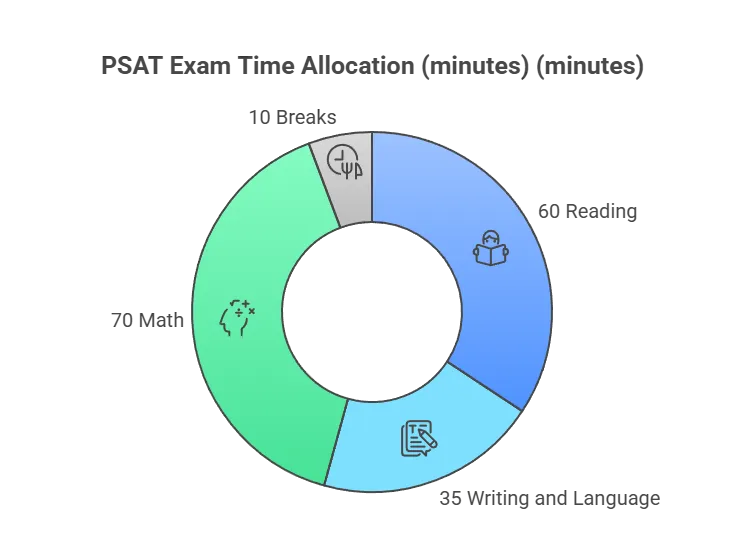What Is the PSAT?
Explore the complete PSAT overview, including format, timing, sections, and preparation strategies to boost your score and get ready for the SAT with confidence.

Key Points
- The test is designed to be completed in one sitting.
- A short break is usually given after the Reading section.
- Time management is crucial, as each section is tightly timed.
- The PSAT no longer has separate “No Calculator” and “Calculator” math sections—students may use a calculator throughout the Math section
Introduction
Around 3.5 million students took the PSAT in 2024 to prepare for the SAT and to be eligible for the National Merit Scholarship Program.
Students take the Preliminary SAT, or PSAT, to determine their eligibility for scholarships. The purpose of the exam is to evaluate high school students’ reading, writing, and math abilities.
With a maximum score of 1520, the PSAT helps students evaluate how prepared they are for the SAT and highlights areas for improvement. There are two benefits to preparing for the PSAT: it improves SAT scores and increases the chance of receiving scholarships depending on your performance and score.
Many students use their PSAT results to boost their confidence before the exam and to prepare for the SAT.
What Types of Merit Scholarships Are Awarded?
Merit-based scholarships are awarded based on several criteria, including leadership, academic achievement, extracurricular involvement, and standardized test performance, such as the PSAT. These scholarships reduce educational expenses by providing financial assistance to deserving students.
Common types include:
- National Merit Scholarships – Based on PSAT scores and academic performance
- Corporate-Sponsored Scholarships – Offered by businesses to children of employees or based on career interests
- College-Sponsored Merit Awards – Provided by universities to attract top-performing students
- Private Organization Scholarships – Given by nonprofits or foundations for various academic and leadership achievements
Note: Each type varies in amount, eligibility, and renewal criteria.
What Is the Value of the PSAT?
There is more than one use for the PSAT besides just being a practice test. It helps students get scholarships, gives them early information on how ready they are for school, and helps them plan for college in the long run. Here are some of its most important benefits:
| Benefit | Details |
|---|---|
| SAT Preparation | Mimics SAT format and timing, helping students practice under real test conditions and identify areas for improvement. |
| Scholarship Eligibility | Qualifies 11th-grade students for the National Merit Scholarship Program, which awards over $33 million annually. |
| Academic Feedback | Provides a detailed score report that shows strengths and weaknesses in Reading, Writing, and Math. |
| Career Planning Tools | Includes access to College Board and Khan Academy resources for targeted test prep and career exploration. |
| College Recruitment | High scores may attract interest from colleges through the Student Search Service, leading to early outreach and scholarship offers. |
| Confidence Building | Reduces test anxiety by familiarizing students with standardized test procedures before taking the actual SAT. |
| Max Score | The PSAT has a maximum score of 1520, helping students estimate their potential SAT performance and set realistic college admission goals. |
How Is the PSAT Timed?
The PSAT is structured to assess students’ critical thinking and problem-solving skills across three main sections: Reading, Writing & Language, and Math. The total test duration is 2 hours and 14 minutes, excluding breaks.
Here’s a detailed breakdown of PSAT timing:
| Section | Number of Questions | Time Allotted |
|---|---|---|
| Reading | 27 questions | 32 minutes |
| Writing & Language | 27 questions | 32 minutes |
| Math | 44 questions | 70 minutes |
| Total | 98 questions | 134 minutes |
What Is a Good PSAT Score?
A good PSAT score depends on your goals, but generally, a composite score above 1150 is considered strong and places students above the national average. For those aiming for the National Merit Scholarship, a score between 1400 and 1520 is typically needed, depending on your state’s cutoff. The PSAT is scored between 320 and 1520, combining the Math and Evidence-Based Reading & Writing sections. High scores not only boost scholarship chances but also reflect strong college readiness. Students can use their PSAT results to plan SAT prep and strengthen academic areas before taking college entrance exams.
How Long Is the PSAT?
The PSAT is a timed standardized exam that lasts 2 hours and 14 minutes. It assesses students’ skills in Reading, Writing, and Math, and is designed to reflect the structure of the SAT.
Reading and Writing
- Number of Questions: 54
- Time Allotted: 64 minutes
- Focus: Reading comprehension, grammar, vocabulary, and editing skills
Math
- Number of Questions: 44
- Time Allotted: 70 minutes
- Calculator: Allowed for entire Math section
- Focus: Algebra, problem-solving, data analysis, geometry.

How to Prepare for the PSAT?
Preparing for the PSAT helps students improve test performance, identify strengths, and build confidence for future standardized exams.
- Understand the Test Format: Learn the structure, question types, and timing of each section.
- Take a Practice Test: Start with a full-length PSAT practice test
- Review Score Reports: Identify strengths and areas needing improvement from practice test results.
- Use Official Study Materials: Rely on trusted sources like College Board and Khan Academy for prep.
- Build a Study Plan: Set a schedule to cover all sections over time with regular practice.
- Focus on Weak Areas: Spend extra time on topics or sections where your score is lower.
- Improve Time Management: Practice answering questions within the set time limits.
- Read Daily: Build reading comprehension and vocabulary by reading newspapers, articles, or books.
- Take More Practice Tests: Simulate real test conditions for better readiness.
FAQ’s
▶ When Do You Take the PSAT?
In October, when they are in 10th or 11th grade, most students take the PSAT. The test is given once a year, and your high school usually manages the scheduling. To be eligible for the National Merit Scholarship, you must be in the 11th grade. However, being involved in the 10th grade makes it easier to start preparing for the SAT early.
▶ How Many Times Can You Take the PSAT?
The PSAT may be taken a maximum of three times, once during each of the 9th, 10th, and 11th grades. Nevertheless, only the score from the 11th grade is taken into account for the National Merit Scholarship. Prior experience is beneficial for practice and aids students in improving their understanding of standardized exam structures.
▶ What Is on the PSAT?
Reading and Writing and Mathematics are the two main components of the PSAT. It assesses proficiency in language, numeracy, understanding, problem-solving, and data analysis. The test helps students prepare for the SAT, determine their eligibility for National Merit Scholarships, and assess their academic skills in order to be prepared for college.
▶ How Is the PSAT Scored?
The PSAT total score spans from 320 to 1520, derived from the sum of two part scores: Reading and Writing (160–760) and Math (160–760). The lowest score is 320, and the highest score is 1520. This aggregate score represents total test performance throughout both parts.
▶ What Is the National Merit Scholarship?
Students who get a National Merit Scholarship are chosen based on their high PSAT scores in the eleventh grade. The National Merit Scholarship Corporation, institutions, and sponsors may provide financial aid to the top students who advance to the semifinals or finals. This esteemed academic honor may drastically lower college expenses.

